Sunspots are non permanent phenomena on the Solar’s floor that seem as darkish spots attributable to decrease temperatures in comparison with surrounding areas. They’re related to photo voltaic magnetic exercise and observe an roughly 11-year cycle. Whereas sunspots themselves could appear distant from on a regular basis issues, their affect on Earth’s local weather – notably by means of photo voltaic irradiance – has lengthy been studied.
This led us to discover whether or not photo voltaic exercise might function a predictive indicator for agricultural commodity costs, equivalent to wheat or corn. Intervals of excessive sunspot exercise are sometimes related to hotter and extra variable climate patterns within the higher environment, with restricted however doubtlessly related results on Earth’s local weather. Slight will increase in air temperature might improve crop yields, which might, in flip, place downward strain on costs. Nonetheless, we assume that the impact of sunspot counts is extra prone to manifest over the approaching years reasonably than within the brief time period.
We suggest to discover whether or not a structured funding technique, equivalent to tranche-based entry timing, might reap the benefits of this relationship. By monitoring sunspot exercise and anticipating its potential affect on agricultural output, we goal to evaluate whether or not sunspot information can enhance the timing and efficiency of commodity investments.
Introduction
In accordance with Area Climate Prediction Heart, sunspots are non permanent darkish areas on the Solar’s floor attributable to intense magnetic exercise. They sometimes seem in pairs or teams, differ considerably in dimension and might persist for weeks. Sunspots observe an roughly 11-year cycle, generally known as the photo voltaic cycle, alternating between intervals of excessive and low photo voltaic exercise, which influences the quantity of photo voltaic radiation reaching Earth. In periods of heightened sunspot exercise, the Solar emits barely extra power. Traditionally, prolonged intervals of low sunspot exercise have coincided with colder climates, equivalent to throughout the so-called “Little Ice Age.”
This led us to contemplate whether or not sunspot counts might function a sensible indicator for agricultural commodity costs, notably for wheat or corn. Our speculation is that elevated sunspot exercise would possibly sign extra favorable rising situations attributable to hotter climate, doubtlessly bountiful harvest and driving costs down. We suggest to analyze whether or not this relationship might be leveraged by means of a easy but efficient technique, equivalent to tranche-based funding timing to raised navigate commodity markets utilizing publicly obtainable sunspot information, both in futures and spot costs.
Methodology
Since futures information doesn’t prolong far sufficient into previous, we determined to additionally discover spot costs. Nonetheless, it’s obligatory to mix information from a number of sources to be able to get hold of a steady value collection for every commodity, as availability varies over time.
Concerning sunspot information, this analysis makes use of the dataset of month-to-month imply whole sunspot numbers from 1749 to Could 2025, obtainable from the Photo voltaic Influences Knowledge Evaluation Heart. For consistency with our technique, we rework this information into quarterly frequency, as we goal to rebalance on a quarterly foundation utilizing a tranching strategy. We apply three variants of this methodology:
4 tranches: 12-month holding interval with quarterly rebalancing,
8 tranches: 24-month holding interval with quarterly rebalancing,
12 tranches: 36-month holding interval with quarterly rebalancing.
In our earlier article Evaluation of Value-Primarily based Quantitative Methods for Nation Valuation, we described this tranching technique as follows: Think about common quarterly rebalancing, for instance on March 31, June 30, September 30 and December 31 of every 12 months. Solely a pre-selected a part of the portfolio is rebalanced at every date. This is named industry-standard tranching. Specializing in a 36-month holding interval (12 tranches), the portfolio is split into 12 sub-portfolios. Every tranche is rebalanced as soon as each 3 years (36 months) and contributes 1/12 of the whole portfolio weight. As an instance this strategy, we current a modified instance tailored from the aforementioned article to raised replicate the present context:
On December 31, 1997, the primary tranche is invested; we go brief on underlying asset if the variety of sunspots of earlier month exceeds the desired threshold, in any other case, we don’t make investments. These positions are held till December 31, 2000. A second tranche is initiated on March 31, 1998, and held till March 31, 2001. This course of continues every quarter, leading to 12 staggered sub-strategies with overlapping three-year holding intervals. The ultimate portfolio is the equally weighted common of those 12 tranches.
The identical precept is utilized for the 12-month (4 tranches) and 24-month (8 tranches) holding intervals, with changes within the variety of tranches and corresponding holding durations.
Now, understanding the precept of tranching, we will incorporate it into our technique. Suppose each the quarterly commodity costs and sunspot numbers are ready. The one remaining step is to outline a threshold. If the variety of sunspots in a given quarter is increased (or alternatively decrease) than the chosen threshold, it generates a sign to take a position, both by coming into an extended or brief place utilizing a tranche-based strategy. That is based mostly on the idea that the consequences of photo voltaic exercise might solely manifest over the approaching years, reasonably than instantly. Furthermore, it’s necessary to account for the truth that sunspot information is offered with a one-month lag.
In our analysis, we look at how the funding performs beneath two situations: brief positions are initiated when the variety of sunspots exceeds a predefined threshold (based mostly on the idea that increased photo voltaic exercise indicators extra favorable rising situations and thus decrease commodity costs). Conversely, lengthy positions are taken when sunspot counts fall beneath the edge. Think about that the beginning portfolio worth is ready to 1.
Primary efficiency traits in tables are introduced as follows: the notation perf represents the annual return of the technique, st dev stands for the annual customary deviation, max dd is the utmost drawdown, adjusted Sharpe r is calculated because the ratio of perf to st dev and adjusted Calmar r because the ratio of perf to max dd.
Firstly, let’s discover whether or not the variety of sunspots doubtlessly influences the value of wheat futures, adopted by an evaluation of the spot value.
Futures
For the backtest, we make the most of a dataset of constantly rolled wheat futures consisting of back-adjusted each day information from November 23, 1979, to April 30, 2025 sourced from Premium Knowledge. Earlier than the primary evaluation, let’s check out the futures costs themselves.

As we will see within the graph, the value has a long-term declining tendency (primarily attributable to unfavorable roll yield over time attributable to storage and carry prices). Subsequently, we’ll use a quarterly rolling brief place as a benchmark.
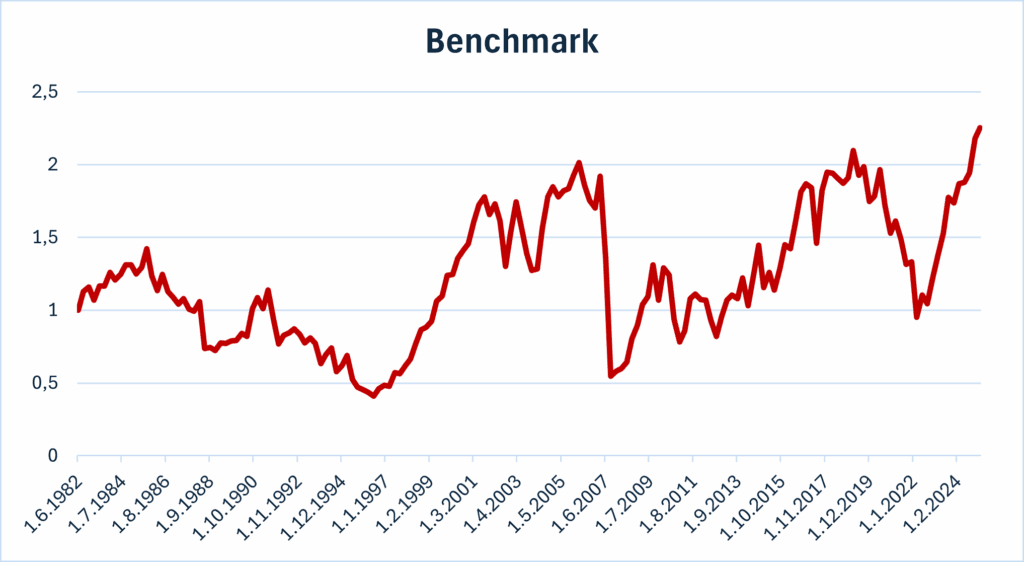
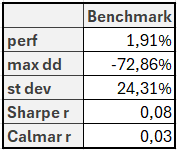
Although the benchmark reveals an upward pattern, its efficiency is just not notably sturdy, with a yearly return barely reaching 2% and markable variablity, exhibiting not solely graphically, but in addition on the results of customary deviation. Can our market timing technique outperform this indicator and ship extra environment friendly outcomes?
Brief positions
We first centered on brief tranching technique, coming into a brief place when the variety of sunspots exceeds a given threshold, anticipating a value decline, with 4 tranches and a number of other threshold values: 30, 50, 80, 100, and 150.


It’s evident that methods utilizing the variety of sunspots exceeding the edge as a sign for brief positioning with 4 tranches are extra worthwhile than the benchmark, which depends solely on a rolling brief place, particularly when the edge is ready to 50. With a return of 5.27%, a typical deviation of 14.83%, and a most drawdown of -45.46%, this technique clearly outperforms the benchmark, reaching a Sharpe ratio greater than 4 occasions increased, in addition to a considerably superior Calmar ratio.
Subsequent, let’s look at the technique with the edge nonetheless set at 50, this time not solely utilizing 4 tranches, but in addition increasing to eight and 12 tranches.
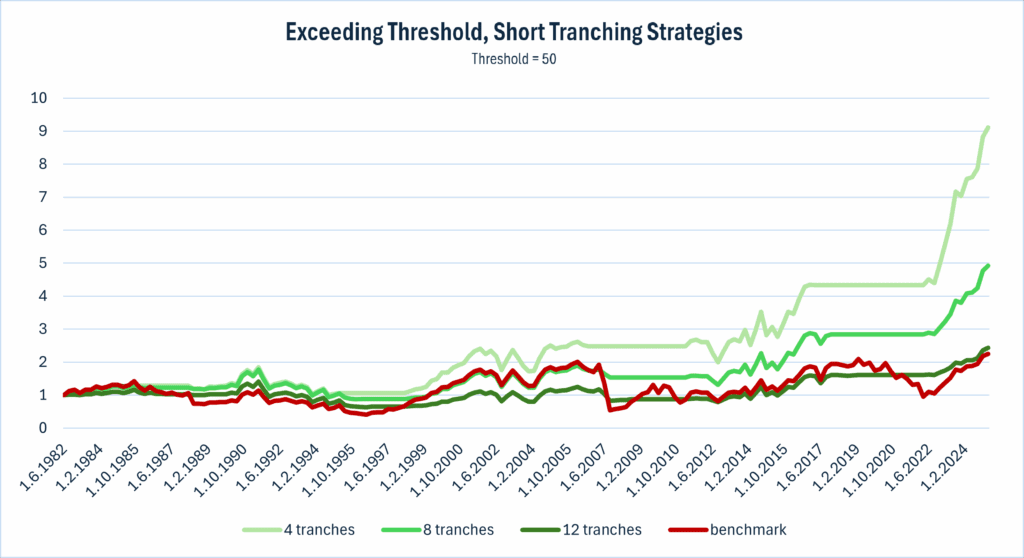

At first look, growing the variety of tranches doesn’t seem like useful for the technique. Each the graph and desk point out decrease effectivity, nonetheless, the technique nonetheless outperforms the benchmark when an acceptable threshold is utilized.
This means that the affect of a rising sunspot quantity is lagged, however as time progresses, its impact steadily weakens. Whereas the shorting technique seems relevant when a value decline is anticipated, it stays unclear whether or not it may be tailored successfully for rising markets (variety of sunspots falling beneath the edge) and lengthy positions.
Lengthy positions
Now, let’s apply the identical process specializing in the variety of sunspots falling beneath the edge set to twenty, 30, 40, 50 and 60, however as a sign for lengthy positioning .
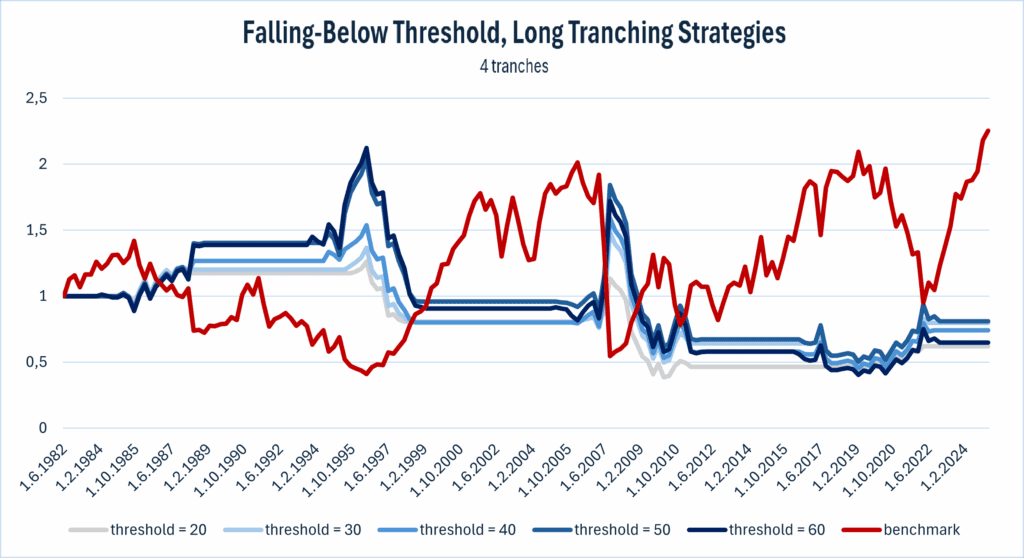

Although there have been intervals when methods based mostly on taking lengthy positions after the edge fell beneath a sure stage outperformed the benchmark, their long-term efficiency remained unfavorable and constantly much less efficient than the benchmark. Subsequently, it nonetheless holds that the one relevant technique utilizing sunspots as an funding sign is the brief tranching technique that make investments when the edge is exceeded, notably when it’s set to 50.
Nonetheless, backtest interval of 40 years is just not so long as we want, however the wheat futures information we’ve doesn’t have longer historical past. For that reason we determined to utilise the spot costs of wheat.
Spot costs
We favor utilizing futures contracts in our evaluation as a result of they inherently replicate storage prices, that are already priced into the market. This makes them a extra real looking instrument for learning commodity value conduct from a buying and selling perspective. Nonetheless, because of the restricted availability of long-term historic futures information, we’d additionally depend on spot costs in our evaluation, since they provide a for much longer information historical past appropriate for learning long-term patterns.
The dataset of spot costs covers the interval from 1842 to 2025 and is compiled from a number of sources. From 1841 to 1944 the info are based mostly on the Wholesale Value of Wheat and for the interval 1944 to 1952 is used Wholesale Value of Wheat once more. From 1952 to 1990 is Producer Value Index by Wheat Commodity utilized and at last, from 1990 to 2025 is used International value of Wheat. The final two datasets have been initially reported in numerous models and due to this fact needed to be transformed to cents per bushel for consistency.
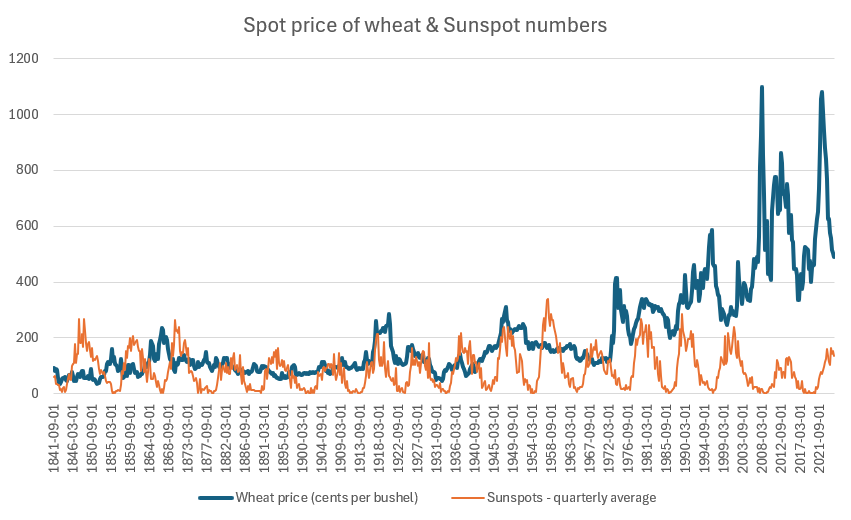
The spot value of wheat reveals a typically upward pattern notably for the reason that Nineteen Seventies, accompanied by a number of vital drawdowns. This sample could also be attributed to the impact of inflation over time.
In distinction to futures, the benchmark is now constructed as a rolling lengthy place rebalanced month-to-month, reflecting the commonly upward motion in spot costs. Nonetheless, as we talked about earlier, this naive benchmark technique doesn’t incorporate storage prices, so we should take all the outcomes from this longer evaluation with a grain of salt.
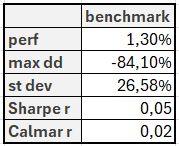
Let’s examine whether or not the beforehand utilized methods will show efficient on this new context. Given the prevailing upward pattern in costs, we start by specializing in lengthy positions initiated when the sign falls beneath the edge. As a primary step, we apply the 4-tranche process (quarterly rebalanced methods, with 12-month holding interval) utilizing threshold ranges set at 20, 30, 40, 50, and 60.


The applying of our technique supplies a extra secure consequence, evidenced by decrease customary deviation and consequently a better Sharpe ratio, though the returns aren’t considerably increased than these of the benchmark. On this case, setting the edge at 50 seems to be probably the most appropriate, nonetheless, we acknowledge that this can be coincidental, given the negligible variations noticed throughout different threshold settings.
Allow us to now look at the efficiency of methods with longer holding intervals (2-years, and 3-years), particularly with 8 and 12 tranches utilizing the identical threshold worth of fifty.
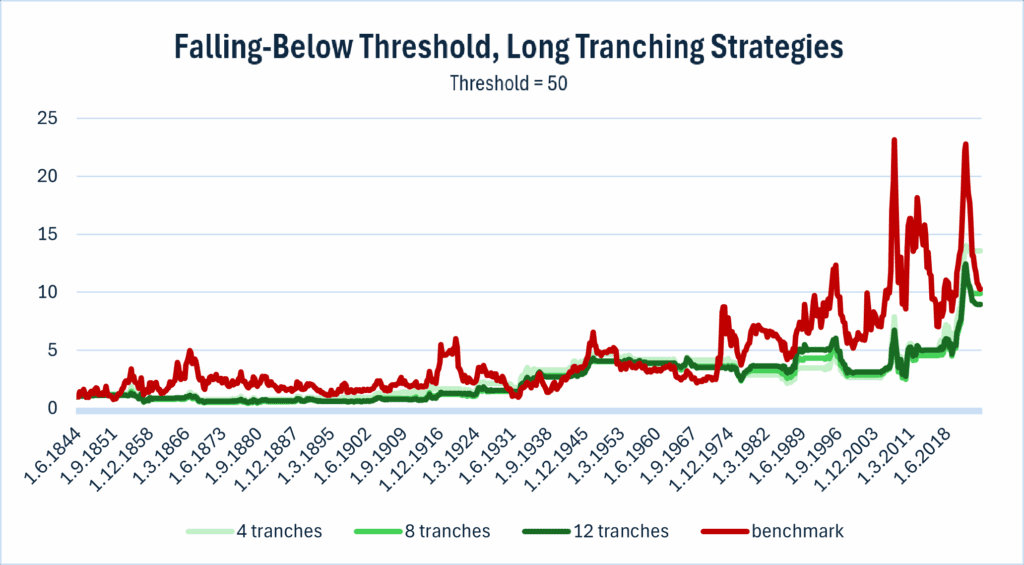

Altering the variety of tranches didn’t lead to any substantial variations, nevertheless it nonetheless led to a extra secure strategy, with a barely increased Sharpe ratios in comparison with the benchmark. Nonetheless, all Calmar ratios remained unchanged.
Lastly, we have been curious whether or not making use of the simplest strategy recognized within the earlier evaluation the technique might produce extra favorable outcomes. Subsequently, we tried brief tranching technique, coming into a brief place when the variety of sunspots exceeds a given threshold, anticipating a value decline, with 4 tranches and a number of other threshold values: 30, 50, 80,100 and 150, expressed in logarithmic costs for higher visualisation.
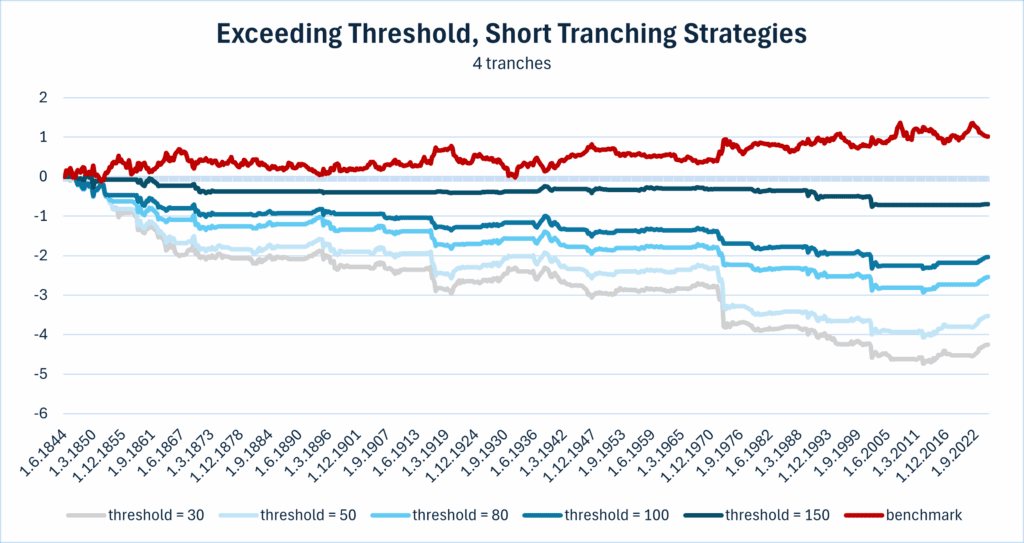

An utility of the brief tranching methods after the edge is exceeded and utilizing 4 tranches didn’t show useful in any case. Detrimental returns, and consequently unfavorable Sharpe and Calmar ratios, underscore the inefficiency of this strategy.
Conclusions
In conclusion, the usage of wheat futures seems not solely extra worthwhile but in addition extra rational, because it inherently accounts for storage prices (which trigger the numerous downwards value drift and we simply must appropriately time entries and exists). If one goals to take advantage of a pure phenomenon equivalent to solar exercise, coming into a brief place when the variety of sunspots exceeds a given threshold with 4 tranches proves to be efficient, notably when the edge is ready to 50, because of the typically declining conduct of futures costs, not just for wheat however doubtlessly for different crops as effectively.
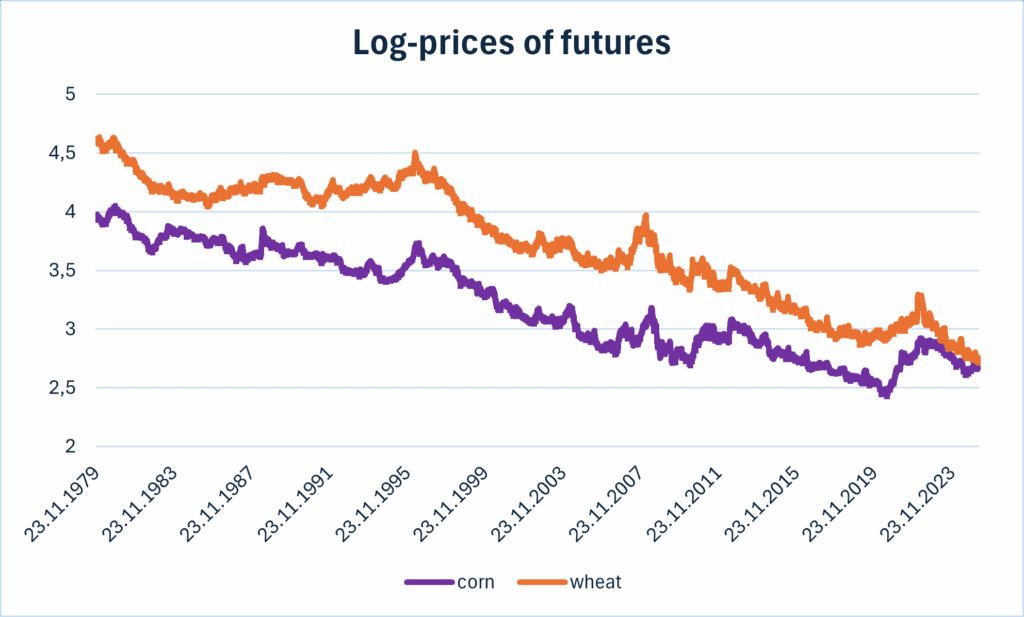
As proven in Determine 11, wheat and corn futures exhibit related conduct over time. Subsequently, the patterns and approaches utilized to wheat futures are additionally relevant to corn futures.
In distinction, the first benefit of utilizing spot costs lies within the availability of a for much longer historic dataset. Nonetheless, this profit comes at the price of lowered technique effectiveness. A protracted place initiated when the variety of sunspots falls beneath a given threshold, notably utilizing the 4-tranche strategy, can outperform the benchmark, albeit solely marginally, whereas providing extra secure efficiency. This impact is most notable when the edge is ready to 50. Nonetheless, these outcomes must be interpreted with warning, as spot costs don’t replicate storage prices. Consequently, whereas the technique might seem worthwhile, incorporating storage prices might reverse the value dynamics, rendering lengthy positions unprofitable. In such circumstances, brief positioning, as carried out with futures, proves extra acceptable.
Creator: Sona Beluska, Junior Quant Analyst, Quantpedia
Are you on the lookout for extra methods to examine? Join our e-newsletter or go to our Weblog or Screener.
Do you wish to study extra about Quantpedia Premium service? Test how Quantpedia works, our mission and Premium pricing supply.
Do you wish to study extra about Quantpedia Professional service? Test its description, watch movies, assessment reporting capabilities and go to our pricing supply.
Are you on the lookout for historic information or backtesting platforms? Test our checklist of Algo Buying and selling Reductions.
Would you want free entry to our providers? Then, open an account with Lightspeed and luxuriate in one 12 months of Quantpedia Premium for gratis.
Or observe us on:
Fb Group, Fb Web page, Twitter, Linkedin, Medium or Youtube
Share onLinkedInTwitterFacebookConsult with a buddy







